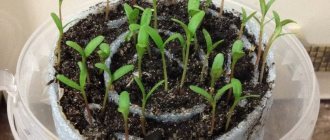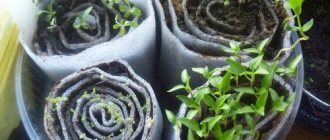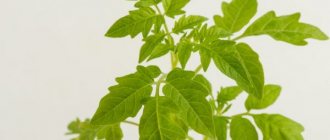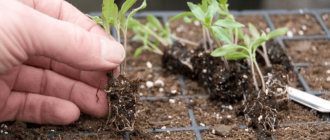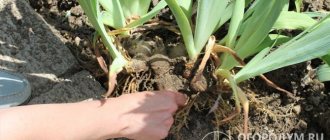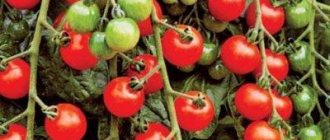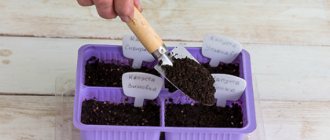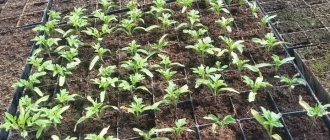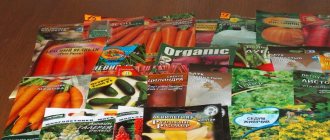Vegetable growing » Tomatoes
0
1617
Article rating
Kira Stoletova
Tomato seedlings using the method of Yulia Minyaeva are especially popular among gardeners. Thanks to the use of this method, it is possible to grow healthy and strong seedlings that are not afraid of temperature changes and show excellent germination when planted in open ground.
Growing tomato seedlings using the method of Yulia Minyaeva
Growing tomato seedlings using the method of Yulia Minyaeva
Tomato seedlings using the method of Yulia Minyaeva are especially popular among gardeners. Thanks to the use of this method, it is possible to grow healthy and strong seedlings that are not afraid of temperature changes and show excellent germination when planted in open ground.
Growing tomato seedlings using the method of Yulia Minyaeva
Sowing seeds into a snail
The snail is a DIY place for growing tomato seedlings. Sowing requires compliance with certain rules. As soon as the substrate is laid on the table, it is completely filled with soil. Tomatoes need the soil level to be equal across the entire width. You should not spread a layer more than 2 cm, otherwise the seeds will take a very long time to germinate.
Using tweezers, place all the tomato seeds in 1 row. To do this, you need to retreat no more than 1.5 cm from the edge of the substrate. The distance between the seeds should be 2 cm. As soon as you reach the edge of the tape, you can begin to roll the roll. The formed snail should stand vertically so that the soil and tomato seeds do not fall out. It is important to fasten the package with rubber bands and place it in a plastic container. You can use any box previously used for planting vegetables.
Next, the seed is watered and covered with a plastic bag so that some air gets inside. As soon as the bundle is completely formed, it is placed in a warm, dark place. As soon as the first tomato shoots appear, the bag is removed.
Preparation for sowing into snails
First of all, you should worry about preparing the place where sowing will take place. It is better to use a table, because its surface is flat and it is much easier to lay out all the necessary equipment on it.
Yulia Minaeva recommends pouring only moistened fertile soil into a prepared container: it is easier to work with. For tomatoes it is better to use black soil. It is important to prepare the seeds in advance: they must undergo a disinfection procedure using a manganese solution (5 mg per 1 liter of water).
To form the snail, Yulia Minaeva recommends using a substrate that builders often work with. It is important to acquire a strip whose width is about 12 cm. You can choose the length yourself. In addition, it is important to use rubber bands that will secure the formed package.
Social networks Minaeva
An active pensioner maintains several pages on several social networks. Yulia Minyaeva has been registered on Odnoklassniki (https://ok.ru/profile/550906857588) since 2013. Here she shares photos of her plantings, seedlings, flowers and adds links to videos on YouTube. Almost 13 thousand people have subscribed to it.
3 years ago, Yulia Minyaeva created a page on VKontakte (https://vk.com/id257485924), on which she posts fresh photographs and videos. Here she has almost 10 thousand friends and 14 thousand subscribers. Also on the VKontakte network, Julia leads the group “In the Garden or in the Vegetable Garden” (https://vk.com/vo_sadu). It has more than 23 thousand members. Useful information for gardeners and housewives is posted on the group wall. Participants not only actively comment on Minyaeva’s posts, but also share recipes, life hacks, and photographs.
A year ago, Julia registered on Instagram (https://www.instagram.com/vo_sadu_li_v_ogorode/). On this network she posts photos of her harvest, greenhouses, ornamental plants and much more. Currently, 4.5 thousand people have subscribed to it.
Minyaeva’s video channel on Youtube is in great demand (https://www.youtube.com/channel/UCiWA1Ct_IdiUA8a-DTwBj9A/featured). Here, an experienced housewife reveals the secrets of the harvest, shares recipes, talks about raising poultry and shows off her garden plot. 370 thousand people have subscribed to her channel!
Thanks to the Internet, Julia not only helped thousands of housewives and summer residents with advice, but also made friends all over Russia. And her plans are only to increase the number of comrades and continue to share experiences!
Picking seedlings in a diaper
Diapers are used to carry out the picking process.
Before you get started, it is important to prepare several basic components: a container with moistened fertile soil, plastic bags, a sprayer and a shovel. The bags will be used as diapers. Depending on the size of the tomato seedlings, bags of suitable size are used. It is important that the seedlings feel comfortable. If only 4 leaves appear on the plant, you can use small bags of 20 x 30 cm.
Prepare everything you need for picking
At the bottom of the container with soil there should be organic components (sawdust or wood ash). They will act as fertilizer. A sprayer is necessary to moisten the soil in the container if necessary. Thanks to the spatula, it is more convenient to remove seedlings from the bundle.
Tatyana Orlova (candidate of agricultural sciences):
Only waste from processing deciduous trees (not oak) is suitable as sawdust. Pine sawdust contains resin, and oak sawdust contains tannins, which negatively affect the roots of vegetable plants.
Swaddling process
First of all, you should unroll the package until the first tomato seedling appears. It needs to be taken out of the snail and placed on the table. A little earth (about 5 cm high) is poured into the bag that will serve as a diaper. It must be watered with a sprayer, after which the seedlings are placed.
The roots need to be covered with soil so that they are not visible even after watering. According to Yulia Minyaeva’s method, the bag is tied with an elastic band where the tomato cotyledons begin to form. Watering is carried out vertically so that the water reaches the base of the stem.
Advantages of the diaper sowing method
The main advantage of this method is that anyone can stop working at any time. The harm to the remaining plants is negligible. As soon as you need to leave, the snail is folded into its original position.
Thanks to the diapers, the gardener saves space on the windowsill: this is where the containers should be placed before planting in open ground. Vertical containers take up much less space than regular specialized planting containers.
The amount of soil required for cultivation is minimal compared to conventional methods. When swaddling, soil is used only to fix the roots at the base. There is one more advantage: the roots do not intertwine and are not deformed.
Tatyana Orlova (candidate of agricultural sciences):
The listed advantages of growing tomato seedlings in snails: saving space for seedlings, saving soil are also its disadvantages. To obtain normal 45-50 day old seedlings, each plant requires a volume of soil of about 125 cubic centimeters (a cassette cell with an area of 5 x 5 cm and a depth of 5 cm). It's minimum. When grown in a snail, there are only about 50-70 cubic centimeters per unit of seedling! Just as a person who did not receive adequate nutrition as a child grows up small and puny, so a productive plant cannot be obtained from tomato seedlings grown in this way.
What it is?
Any gardener knows how quickly space on the windowsill runs out when installing boxes with seedlings there. And if there are still indoor flowers there, then temporary difficulties begin to look more like a disaster. The problems don't end there. Containers with soil can be repeatedly turned over by children and pets, which adds to the hassle of cleaning.
Traditional planting of seedlings requires quite frequent watering; skipping this event can quickly destroy young seedlings. And watering itself requires you to spend a lot of time to bring moisture to each plant.
Planting in snails and diapers easily solves these problems. A simple and convenient design made from scrap materials allows you to save a lot of time by fitting almost all the seedlings on one windowsill.
Snails are most often constructed from the construction substrate left behind the laminate after repairs. Pieces of plastic film are used as diapers. Rolling a snail or a diaper is very easy; this method does not require special skills. Just read about it or watch the video once and you will succeed.
Initially, the seeds are sown in snails - rolled material rolled in a circle, between the layers of which the seeds will germinate. In a small area you can easily place two dozen such structures, and even more.
When picking, the seedlings are transferred to diapers - individual packages placed in a common container. Caring for such seedlings will be much easier, and when subsequently planted in open ground, the roots will not suffer damage, which will allow the plants to adapt faster.
Snail for seedlings. Where to start: video
From diapers to open ground
Seedlings are planted in open ground in early April, but they are hardened off in advance to reduce the risk of damage due to temperature changes. Landing is carried out early in the morning or in the evening. It is important that there is no direct sunlight. Yulia Minaeva recommends planting plants according to a certain pattern: a distance of 50 cm should be maintained between bushes, and about 70 cm between rows. After planting in open ground, tomato seedlings need shading. It is better to create a paper shelter for them so that the sun's rays do not disrupt their development.
The bushes are watered once every 3 days. About 2 liters of warm water are poured under each plant. Feeding is carried out only 3 times.
Gartering of bushes is carried out at the age of 30 days, from the moment of planting. To do this, it is advisable to use metal pegs and thick fabrics.
Source
How to dive into a diaper
Seedlings grown in snails develop rather slowly. They should be plucked when sprouted roots appear from the lower cut of the snail. If some plants develop more slowly than others, it’s not a problem. You can only pick up grown seedlings, and wrap the rest back in the snail and grow them a little.
For picking, you will need to prepare the same thing that you used the first time, with the exception of the substrate. Bags made of thick film will become a new “house” for plants. You can use used covering material for these purposes, it does not matter.
Wrapping plants in diapers will require a little more time, because now each seedling will be grown individually. But saving soil and space on the windowsill will be present in this case as well.
The sequence of actions at this stage will be as follows:
- The film must be cut into pieces the size of a notebook sheet.
- Place a tablespoon of damp soil near the top edge in the left corner.
- Place the seedling on the ground, carefully straightening the roots, then placing another spoonful of soil on top. The leaves should extend beyond the film.
- After this, the lower edge of the film is folded in and the structure is rolled into a roll.
- The plant in the diaper is secured with rubber bands in two places and watered with water to which fertilizer has been added.
- Seedlings in a diaper are placed vertically in the same containers that were used for snails and transferred to a sunny window.
On a note! This method is also suitable for germinating seeds. In this case, the seedlings will not require picking, but can be grown until the stage of planting in open ground.
Diving into diapers is especially suitable for those crops that are planned to be planted in a greenhouse. The fact is that this method is convenient for summer residents, but it restricts the roots of the plants themselves. If you keep the seedlings in diapers, their condition may worsen due to the limited possibility of developing the root system. And weather conditions do not always allow plants to be planted in open ground in a timely manner, but a greenhouse solves this problem.
When planting diaper seedlings in open ground, you can use a cushion of straw or sawdust, then the roots of the seedlings will not freeze. Cover the top of the seedlings with film or use plastic bottles with the bottom cut off, covering each plant with them. Soon, in a large volume of soil, the root system will become stronger and, with proper care, such specimens will produce a full harvest, in no way inferior to vegetables whose seedlings were grown in the usual way.
Picking seedlings from snails into diapers: video
Features of growing tomatoes in a snail Yulia Minyaeva
Professor, Head of the Department of Vegetable Growing
Among the vegetable crops that are popular among gardeners, tomatoes are in the top three. Their productivity directly depends on the quality of the seedlings.
How to grow healthy young seedlings in cramped conditions, when sometimes there is not enough space on the windowsill shelves. The question is relevant for summer residents living in city apartments. Planting tomatoes in Yulia Minyaeva’s snail will allow you to compactly arrange the seedlings and get strong shoots.
What plants can be grown in snails
The method of growing seedlings in snails is suitable for almost all vegetable and berry crops, as well as flowers. The seeds of these plants do not need a light source to sprout. This new method is successfully used by summer residents to grow seedlings of zucchini, cabbage, peppers, tomatoes, eggplants and other vegetables.
You can plant strawberry and wild strawberry seeds in the snail. Seed material of various colors germinates well in such conditions, which will then decorate the flower bed in the garden.
On a note! This method of planting is not suitable only for root crops (beets, carrots), since seedlings require further replanting, and the fruits may become distorted because of this.
Yulia Minyaeva’s method: features and purposes
Yu. Minyaeva came up with the method of growing seedlings in a “snail” and began to popularize it recently. Among summer residents and gardeners you can find many positive reviews. Most adopted the technique. Minaeva plants seedlings in rolled rolls of foamed plastic film and toilet paper. A similar technique is used for growing seedlings, with further picking or planting directly into the ground.
Features and advantages of the “snail” method by Yulia Minyaeva:
Important. The main purpose of the new technique is to provide favorable conditions for the development of young seedlings. Optimization of seedling growing processes.
Minaeva plants tomatoes in several ways, followed by planting them directly into the ground. The choice of method for planting tomatoes depends on the variety, time of planting seeds for seedlings, and weather conditions.
Note. Long-term weather forecasts should be taken into account. What type of spring will it be this season: early or late? Weather conditions make adjustments to the timing of planting seedlings.
Preparing seeds for seedlings in snails
Seeds for seedlings in snails are prepared in the usual way. First you need to sort them. It is better not to use small and damaged seeds.
If necessary, the seeds are hardened. To do this, they should be placed in the refrigerator for a while and then left at room temperature.
It is also useful to feed the seeds with ash or various preparations. Before planting, the material is disinfected.
Products that can be used for pre-sowing treatment:
- phytosporin (disinfectant);
- potassium permanganate (disinfectant);
- epin (growth stimulator);
- zircon (growth stimulator);
- hydrogen peroxide (disinfects and improves seed germination).
Yulia Minyaeva recommends germinating the seeds before planting them in snails. To do this, you need to lay them out on a thin cloth, wrap them and wrap them with thread.
The resulting packages are placed in a jar and filled with a solution of an antiseptic or germination stimulant. After the time indicated on the drug packaging, the liquid must be drained. The seeds remain in the jar, which should be tightly closed and placed in a dark, warm place.
The thinner the fabric used, the easier it is to monitor seed pecking. When preparing seed, the characteristics of different plant species and varieties should be taken into account.
Seedlings in diapers - saving space and soil
Growing seedlings is a very labor-intensive process. Typically, gardeners prepare containers for seedlings in February (plastic cups, yogurt containers, sour cream containers) and arm themselves with kilograms of soil. And permanent residents of window sills move to less comfortable places, giving up the rays of the sun to their young brothers. However, all this can be done much easier. Recently, gardeners often plant seeds in so-called diapers. By the way, this method is sometimes called Moscow-style seedlings, because in the capital every centimeter of space is valued!
This method allows you to:
Significant advantages and disadvantages of this method
The effectiveness of Yulia Minyaeva’s method has been proven by many of her followers. They share their successes. In the gardening community, the nuances of the technique are discussed on forums, people make their own adjustments, and discuss the advantages and disadvantages.
The main advantages of the technique:
Gardeners in the reviews note: you should not turn on the backlight often. Tall varieties are very elongated. Additional light is needed when seedlings develop poorly due to lack of lighting.
Sometimes seedlings do not germinate well and yellow leaves appear. There are different reasons: insufficient watering; high concentration of fertilizing; The plant does not have enough light.
It is recommended to conduct an independent experiment, planting seedlings in the traditional way (in a container, followed by picking into cups). Plant some of the seeds in the “snail”. Observe the development of the plant and draw conclusions.
Advantages of the method
Advantages of Yulia Minyaeva’s method of planting seedlings:
- Grown seedlings acquire a more powerful root system. Correct root development is achieved due to the fact that the plants are at the same distance from each other and will not interfere with each other.
- Watering is carried out more efficiently and is not problematic; it is enough to pour 100-200 ml into the container.
- If you plant seedlings in a snail or a diaper, they will not actively gain growth. As a result, all energy will be saved for open ground.
- Sowing seeds in a diaper allows you to reduce the area for growing crops.
- It is easier to pick seedlings from snails or diapers without harming the root system.
What varieties of tomatoes are suitable for growing in a snail?
Roll planting of tomato seeds is suitable for all varieties. It is necessary to take into account the speed of ripening (early ripening, mid-ripening, late ripening). The type of tomatoes is important: tall, short. The timing of planting seeds for seedlings is adjusted accordingly: February, March, April.
Gardener with 17 years of experience and our expert
Attention. It is important in what way the plants will be planted, with a pick or directly into the ground, in a greenhouse. The climate zone determines the time when the soil warms up enough for seedlings to be planted.
There are determinate varieties; their vegetative development limits growth until a certain number of clusters ripen. Indeterminate varieties are tall, and in favorable conditions they continue to grow and develop. The former are suitable for planting in low greenhouses, while the latter are given a place in the central rows of stationary greenhouses.
Greenhouse
A positive property of hybrids (F1) is the uniform development of fruits in clusters of different ripening periods.
Determinate varieties for greenhouses:
Hybrids F1: Bujuy, Azhur, Olya, Doll Masha, Kasamori, Tolstoy, Sir Elian.
Large-fruited: Alsou, Doll F1, Spring of the North F1, Pink Paradise F1, Honey Spas.
For open ground
There is no clear division between tomato varieties that are grown in open ground and greenhouses. Depending on weather conditions, individual varieties perform well in different conditions.
Early ripening varieties (80–95 days) develop well in open ground: Krakowiak, Antoshka, Alpha, Aquarelle, Supermodel.
Variety Supermodel
Unpretentious tall ones: Bogatyr Maslova, Beefsteak, Barmaley, Giant Lemon, Big Beef hybrid.
New F1 hybrids: Gaiduk, Cyrano, Azhur.
Salad: Dina, Miracle of the Earth, Pink Flamingo, Quiz, Siberian Miracle.
Early: Lyana, Gavroche, Arctic, Linda, hybrid Aurora. With increased resistance to late blight: Gnome, Oak.
How to properly plant tomatoes in a “snail”
Roll planting of seedlings is not as labor-intensive as planting in containers, followed by planting, for example, in peat cups. “Snail” will save space, money, and time.
Seed preparation
First you need to keep the seeds for several days in a warm place: on a gas boiler, a slightly hot radiator. If the windows face the south, southeast side, lay the seeds on a gauze pad and expose them to the sun.
See also How to grow tomatoes on a windowsill in an apartment
Then the seeds are disinfected in a 2% manganese solution for 10–15 minutes. An alternative may be a 3% hydrogen peroxide solution. Not only are the seeds disinfected, but their development is also stimulated. Soak for 40–60 minutes. The germination and productivity of tomatoes is increased by the juice of the homemade aloe healer plant. It is enough to dip the seeds in it for 2 hours.
The protective properties of seeds are stimulated by certain preparations: Agata-25, Biostim, Novosila.
Yulia Minyaeva’s technique involves sequential planting of tomato seeds. In the third ten days of February - late-ripening, tall species. The remaining varieties are planted before March 10.
Traditionally, seedlings are planted at this time. Under film, in the ground - in the 2nd–3rd decade of March. Early ripening, in the ground - in early April. Low-growing, in the greenhouse - 1–2 ten days of April.
Landing without soil
First you need to prepare all the necessary materials.
What you need to make a “snail”:
For the convenience of making a “snail”, Yu. Minaev recommends making a special board. Two plastic construction corners (with sides up to 5 cm high) are screwed to the strip of laminate. The distance between them is 18–20 cm.
Seeds are selected taking into account the conditions of the climatic zone. Optimal growing conditions, in a greenhouse, open ground. Proven seed material is planted.
Sowing sequence without soil:
Note. Yu. Minaeva emphasizes that it is important not to miss the moment of seed germination. As soon as the sprouts appear, remove the top film and place the snail with the tomato sprouts on the windowsill.
Seeds germinate within 4–5 days. When the sprouts produce several cotyledon leaves and the first fully mature ones, they are dropped into peat, plastic cups.
Planting seeds with soil
Preparation for planting seeds is carried out in the same way as when planting without soil.
Important. By growing seedlings in this way, in the future you can choose two types of transplanting young plants: into diapers or directly into the ground.
Lay out the backing, only make the height of the roll 3–5 cm larger, up to 20 cm. Roll out toilet paper onto the backing. Similar to the first option, moisten it with a solution of water with growth stimulants and aloe juice.
The seeds are laid out, retreating from the top edge to 3–4 cm. The distance between the seeds is 10 cm.
We sow tomatoes according to the scheme described above, twist the snail. Place in a container with sawdust and cover with film. Transfer to a warm, dark place. After 2-3 days we open the snail. Seeds that do not “hatch” are carefully removed and replaced with new ones. Sprinkle the unrolled snail with soil (up to 1.5 cm) on top and roll the roll again. Place the container covered with film in a warm, dark place until the first shoots appear. Then they open it and transfer it to the windowsill.
Next, when the seedlings have sprouted, cotyledon leaves and the first fully mature ones have appeared, the snail is carefully untwisted and another layer of earth is added, about 1.5 cm. Twisted again and secured with tape. They are placed in containers in nurseries. Water by adding slightly warmed water to the bottom of the container and drip-sprinkling soil into the snail. The result is seedlings that can be planted in the ground. Before transplanting, you need to remove the cotyledon leaves, bury the plant in the ground a centimeter before the first fully mature leaves.
The second option is to plant sprouted seedlings in diapers.
Picking seedlings
Yulia Minaeva recommends planting seedlings from the “snail” with soil in “diapers”. The technique is so named because of the analogy with the process of swaddling a baby. When the seedlings, planted in a snail with soil, grew up, several pairs of fully mature leaves appeared, and the seedlings dived.
See also Productivity and description of the tomato variety Red Krasno f1
Polyethylene cups are placed in containers. Watering is carried out by supplying water to the pan, wetting the seedlings in a drip manner from above the soil. When the earth subsides, soil is added to the “diapers”.
During the growth process, seedlings are fed with “Aquamix”, “Gumate”, “Rassadorost”. Spray with Fitoverm, the drug will protect young shoots from diseases.
Specifics of growing without picking
The main thing when growing tomatoes for seedlings without picking is that they do not overgrow. If the sprouts are very elongated, Yu. Mityaeva recommends tearing off the cotyledon leaves. Twist the stem slightly (until the first fully mature leaves). This will slow down growth and strengthen the root system due to the formation of additional root shoots.
Important. Observe the timing of planting seeds for seedlings, in the ground, monitor the temperature regime. Carefully study the instructions and recommendations on the bags of seeds.
Seedlings grown with soil according to Yulia Mityaeva’s method can be transplanted directly into the ground. Taking into account the climate zone, they are planted in a greenhouse or in prepared open beds.
How to prepare the soil for planting tomatoes according to the recommendation of Yulia Mityaeva:
This substrate will provide additional nutrition and warmth to tomato seedlings.
Gardener with 17 years of experience and our expert
Need to remember. Only burnt manure and poultry humus are added. Fresh organic fertilizer can “burn” seedlings.
Yu. Minyaeva believes that such a bed will provide tomato seedlings with all the necessary nutrients; no additional feeding of tomatoes is required.
Basic mistakes
Some gardeners complain that they are unable to grow high-quality seedlings in snails and diapers. But the cause of problems is often their own oversight. Here are some typical mistakes that are made with this method of growing:
- The shelter from the snails is not removed in a timely manner. As a result, the seedlings become stretched and may develop blackleg disease. The bag must be removed from the seedlings when the first shoots appear.
- Some people refuse soil and instead put several layers of toilet paper in the snail. You can often find such recommendations on the Internet. In fact, toilet paper cannot provide seedlings with nutrition and is not able to retain moisture for a long time. As a result, seedlings grow poorly and can quickly dry out if watering is not timely.
- It happens that a summer resident rolls up a snail too loose, believing that this will give the seeds the opportunity to germinate unhindered. In fact, at the first watering, the tiny seeds will simply slide down, which will complicate their further development.
- A gardener may simply confuse the top and bottom of the snail when placing it in a container. Thus, the seeds will be almost at the bottom of the constructed structure.
- Planting seedlings too early. Frail seedlings always do not tolerate transplantation well. Carry out this procedure only after roots appear on the lower section of the snail.
When and how to pick tomatoes. Why do this
In this article we will tell you what picking is and why it is needed. How and when to pick tomatoes according to the lunar calendar for 2022 and at what stage of seedling development to do this.
Picking is an intermediate transplant of seedlings: less frequently or into another container. The main goal is to save initial space in protected soil and help the active development of the plant’s root system.
As stated at the beginning, the main goal is to save space when sowing. That’s why they sow as densely as possible, and when the plants become crowded, they replant. At the same time, the similarity of the seeds is not so important - when transplanting, we will form the desired density, regardless of the percentage of ungerminated seeds. If there are any extra ones, we will immediately cull them, throwing away those that are damaged or lagging behind in development.
Picking is not a necessary technique, if the space, for example, in a polycarbonate greenhouse allows and we are not going to grow anything else for now, you can immediately sow less often and not carry out the technique. Then time and effort are saved.
Benefits of picking:
Typically, picking is carried out at the stage of appearance of the first true leaves.
The timing of the pick depends.
The tomato tolerates replanting well, it can be done at the earliest possible time, only with cotyledon leaves, but why? It’s more convenient to sow a little less often and plant later.
On average, gardeners pick up seedlings at the age of 7-10 days.
Inaccurate diving can delay the development of seedlings by 7 days!
There are people who like to make two or even three picks, and plant large plants with already formed buds. It is labor intensive, but you can get a very early harvest.
We take into account that each transplant, even the most gentle one, slightly slows down the development of the plant, but Oktyabrina Ganichkina voices the idea that the more transplants, the better.
The best sign for picking and transplanting is Virgo. It is especially suitable for crops that were planted when the Moon was in the sign of Cancer, Scorpio or Pisces.
In this case, the seedlings tolerate diving easily, almost do not get sick and quickly recover from the procedure.
Table of favorable days for picking tomatoes according to the lunar calendar for 2022.
It is not recommended to pick seedlings on the following days:
Before the Full Moon and New Moon, on its day and 12 hours after it, you can’t pick tomato seedlings!
The main thing is not to forget to water the soil with seedlings generously a day or two before the planned procedure. In this case, tomatoes are less injured.
Should I trim the main root?
It is not recommended to deliberately pinch the root of small 2-week-old seedlings - this will delay the development of the plant
Transplantation is usually carried out from the entire area. But it is permissible to dive partially: move the excess plants, and after thinning out a little, leave them in the old place.
When replanting into cups or other small containers, first pour a small amount of soil, then, holding the sprout with one hand, fill it completely with the other. We compact the soil a little - this will improve the contact between the soil and the roots.
Cherry seedlings are picked in the same way as more common tomatoes with large berries.
Preparation
Wash the beets and grate them on a coarse grater or, to reduce labor costs, use a food processor. We will stew the prepared beets. A large, thick-bottomed stainless steel pan works well for this.
Ingredients and utensils
Place the grated beets in a saucepan. Add salt, sugar, vegetable oil, vinegar and water.
If your beets are very sweet, then you can put less sugar, in this case it is better to focus on your taste. The volume of water of 300 ml is also given approximately, since beets can be of different juiciness, but more on that below. No need to add any spices.
Mix all the ingredients thoroughly and place the pan on the stove. The beets are stewed over low heat for 2 hours after the start of boiling. You need to stir it regularly and make sure it doesn’t burn. If you see that there is not enough water for stewing, you need to add a little boiling water (100 - 200 ml).
There should be enough water for stewing. Place the finished beets in sterilized jars, compacting the mass a little with a spoon from time to time, so that there are no voids occupied by air. We seal the jars and turn them over.
You can see the whole process of preparing beets by watching the video. Its author is the famous blogger Yulia Minyaeva. Yulia also talks in detail about how she sterilizes jars in the oven and then uses them for preparations.
Georgian tomatoes are another delicious tomato appetizer. Salted tomatoes recipe: https://goo.gl/S5ytT2 Assorted.
Apples for the winter in a jar! | Apple Recipe In Season.
Soaked apples. My grandmother's recipe. Other recipes for winter preparations: Tender, crispy cabbage! https://www.y.
I cook them again and again! Flatbread in a Frying Pan With Potatoes. Giveaway from KITFORT.
THE GIVEAWAY IS CLOSED. How to make flatbreads is the topic of this video. Planetary mixer Kitfort KT-1308-2, white https://goo.
Awesome Apple Pie. Even a Child Can Cook!
Bulk pie with apples (apple pie). Subscribe to Channel 7DACH https://goo.gl/sqE5GL Website 7DACH https://7dach.ru/ If you are tired.
Germinating seeds using film method with soil
There are several ways to “swaddle” seedlings. Some people grow plants in diapers with soil or coconut substrate, others without them at all. Some people pack only the seeds in film and then transplant them into cups with soil. And some recommend sprouting sprouts into diapers. In order for you to choose the most convenient method for yourself, we will consider all existing options.
Tip: With any method of using a diaper, you can use a trick. Write the name of the variety or its number on a strip of adhesive tape and stick it on the diaper film. You can also mark the film with a waterproof marker. In this case, wait until the inscription dries. This way you will observe the germination of different varieties, and you simply won’t get confused.
Let's start with germinating seedlings using the film method with soil, using cucumbers as an example.
Read also: Beekeeping for beginners where to start video
Recommendations from Yulia Minyaeva when planting tomatoes and peppers
Yulia Minyaeva is constantly improving her planting methods. In her opinion, the following methods should be used to obtain the best harvest of tomatoes and peppers.
Planting tomatoes
Seeds of late varieties of tomatoes should be sown at the end of February, and mid-season and early varieties - at the beginning of March. Yulia Minyaeva plants tomatoes using toilet paper. She wets the paper with a fertilizer solution.
After the sprouts have sprouted, you should unroll the roll and remove the unsprouted seeds. New ones can be planted in their place. Then a layer of soil 1 cm thick is placed on top, moistened with water and compacted.
After this, the roll needs to be rolled back, sprinkled with soil on top, and watered generously. Julia recommends placing the snail on birch sawdust. Then the plant is covered with cellophane and put away in a warm place. After all seeds have germinated, the covering material should be removed and the seedlings should be placed in the sun.
It is best to pick plants in diapers, but you can do without picking. To do this, the snail needs to be unfolded and placed on another layer of substrate under the laminate.
The fresh layer should be the same length as the old one, but 5 cm wider. This excess material should be located on the roots side.
Then you need to add soil mixed with birch sawdust. The finished snail needs to be rolled up and secured. Add soil on top and water generously. Subsequently, water can be poured directly into the pan.
Planting pepper
Late varieties of sweet peppers are planted in early February, mid-season varieties in late February, and early varieties in mid- or late March. It is possible to use rolls of toilet paper, but it would be preferable to plant seeds in the ground.
The finished snail is topped with earth so that its layers are not visible, and watered generously from a spray bottle. Subsequent waterings are carried out at the bottom of the container where the seedlings stand.
The snails covered with film are placed in a warm place until sprouts appear. Then the covering material should be removed and the seedlings should be placed in a well-lit place.
When the time comes for picking, the snail is unwrapped and strong sprouts are selected, which are transplanted into diapers. The option of landing without picking is possible. In this case, the seedlings are transferred to the greenhouse after one and a half to two months.
